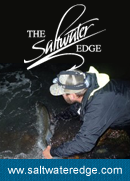
If fish followed calendars than I’d be about a week early, but since the moons have a lot more bearing on their everyday lives than dates printed on paper—this Friday marks the three year anniversary of my own personal surfcasting milestone. There was actually a lot of preparation that went into finding and catching that fish—but there was a lot more luck involved than normal; I’m not too proud to admit that.
It all began back in April when my fishing partner, Dave Daluz, and I signed up for the Red Top Spring Striper Derby, a tournament that Red Top used to run from Thursday night to Monday morning every year over Memorial Day weekend. When you enter a tournament you automatically grab a tide chart and start roughing out scenarios that would lead you to fish one place or another. I consider the weeks between the last moon in May and the first moon in July to be THE BEST weeks to catch a giant from the surf; yes this can be disputed and debated at length, but you won’t change my mind. I have caught fish over 40 pounds in every month of the season except November where I’ve fallen short at 38—but the bulk of my big fish have come in this magic period and I look forward to it every year.
We narrowed it down to three spots, and since May is a migration month, we concentrated on what I refer to as “migrational obstacles”, points of land or funnels that migrating fish must pass by. In the days leading up to the tourney, we pre-fished the three areas. One of them was very slow but, it was also my highest confidence spot, so I was still leaning in that direction. The next was loaded with fish, with some in the high-20’s, not tournament winning fish, but a good sign. The last spot was a place of great memories for both of us, a few years prior we found ourselves in the middle of a topwater bite that would rival anything we’d seen before or since—and that includes all of the Canal blitzes we’d experienced. We arrived there mid-morning on a cloudy day and, before we could even make it to what we consider to be the best location on that stretch of beach, we already had fish to 30 pounds on pencils and spooks—the bite was not fever pitch, but these were the biggest fish we’d found all week. And since fish in the low-30’s usually placed for the shore division, this was the frontrunner for night one of the tournament.
I’d like to say that I felt super confident about going to that spot, but I didn’t. I was more interested in either of the other two—I just had more historical confidence in the others after dark. It was my fishing partner that was focused like a laser on spot #3. Even while we were driving there together I was questioning the choice, but he made a good case and I dropped mine. We arrived at high slack and made our way out among the rocks. As I wrote earlier, we had found the fish in an unlikely spot earlier in the week so we started there.
The water was deep, even up close to shore so fishing was tough and since we were in an unfamiliar location, finding suitable rocks to stand on was hard. Yeah, we forgot to do part of our homework. I found a little “toaster oven” rock that lifted me up high enough to cast and I tossed an eel out into the darkness. I was totally preoccupied with finding a “good” rock so I was scanning the landscape as each small swell passed. After about two casts I saw a very slight break in one of the waves and I knew that there was a tall rock there—I thought to myself, “it’s probably shaped like a pyramid, but I’ve gotta go look!”
In a break from Murphy’s Law, the rock was about the size of a picnic table and almost as flat! I rolled myself up there like a discarded water heater and stood up in 10-inches of water, perfect! I fired my first real cast of the night and within a few cranks I felt a bump and then two hard jerks, I set the hook and my drag sang out under strain! My partner yelled over, “You on? Sounds like a good one!”
The fish came in with relative ease and when I turned on my light I had a nice fish that weighed 28 on the Boga. “You gonna weigh that in?” Dave asked. “No,” I said, “I have a feeling that I’m going to get something bigger.”
A few casts later I felt a bluefish hitting my eel, almost a grinding feeling—needless to say I wanted to get my eel away from those teeth! I reeled up quickly and just as I was about to come tight, the grinding stopped. I could feel weight on the end of the line but no movement. I cautiously reeled a couple more feet of line and I felt the weight again and, again, no movement. In a flash I determined that this must be a bass, I hauled back mightily, but I completely whiffed! I figured I had missed the fish and decided to just crank in and make a new cast.
About halfway in, my rod was being pulled to the right, almost like it was wrapped around something—it just felt odd—and then, I was tight to a fish! The fish had evidentially grabbed the eel and swam right at me, so I whiffed on the hook set, carelessly cranked in my eel and somehow, I still hooked this fish. She ran with serious power right back to where she first found the eel and I turned her. I could feel some serious weight out there but she came in easily for a few seconds. It was unlike any other fish I had hooked. The most memorable thing was the weight. I turned to Dave and said, “I don’t know, but I think I might have a really big fish on right now.”
I hate saying those words because then you’re pretty much guaranteed to have a foul hooked sand shark on your line, the words felt thin and awkward leaving my mouth but, I said them! Then she turned and ran again, this run featured the same power and speed as the first only this time she went to the right, and after about 50 yards she stopped and I was able to turn her again and, after that, I pretty much just reeled her in. When she saw my light things got a little dicier. She was circling my rock a lasso, and was clearly in control of the situation as I spun like a lighthouse beacon. I finally got her in really close and I grabbed the leader. Her mouth opened and I grabbed her jaw, she ripped her lips free of my grasp and started beating the water with her tail. I knew she was big but, I thought she was high 30’s maybe. I pulled her head back to me and made another attempt on her lip, and again, she twisted out of my grip! Now she was pissed, and she was thrashing around while I pinched the leader for dear life. I suddenly had the realization that there was a real chance of losing this fish! In that same moment, she rolled onto her side and I saw the full size of the fish. It all became real in an instant. I was done trying to lip this fish! Before she could roll back upright, I jumped into the water and simultaneously planted my palm on her gill plate, pulling her in toward my body. I wrestled her head against my chest and wrapped my other arm over her back. She thrashed for a second or two and then gave up. I slid my right hand into her gills and the fight was over.
Oddly enough, I still wasn’t sure how big the fish was. Maybe because it was May and I hadn’t seen that many big fish yet, maybe I was afraid to guess her weight? I don’t know. As Dave walked over toward me he asked how big I thought she was. I said, “I don’t know, she’s a nice fish. What do you think?” I held her head up out of the armpit-deep water. “Hmm, looks close to 40 anyway,” he said. He exited the water ahead of me and turned around as I was slogging through the knee-deep surf. I’ll never forget what he said as I held her up, “Dude! That is a HUGE fish, well over 40 pounds!”
He put his Boga on her lip and hefted her high and dry, I saw his eyes widen. “I’ll let you read it,” he said, “but that fish is over 50!” As I looked at that graduated metal tube, I could see the bottom of the 52. Dave asked, “What now? Do you want to shoot some photos?” I said, “NO, I want you to get out on that rock and fish while I re-rig—there could be another one out there!” I pulled the hook out; it was barely in there, just past the barb in that leathery skin on the roof of her mouth. I was astonished by the whole ordeal. I knew I would probably win the tournament with that fish, but I felt a slight twinge of remorse as I laid her in the rocks; I felt a little better when she didn’t even move.
My line was all tied in knots from the wrestling match; I had to completely redo everything. This was a case where every single thing went wrong but I still came out smelling like a rose. I guess you could say that I was meant to catch that fish. I’m sure a few people reading this are saying that they would NEVER let things transpire the way they did, but I am not an inexperienced surfcaster and that fish was mean when I had her close! I am also not a liar, I could have told you that I dragged her to shore with my teeth while flexing my muscles like Hulk Hogan, but the truth is what it is. And things rarely go the way you picture them in your mind.
After re-rigging, I took my position on that rock and we proceeded to catch dozens of nice fish between us; mostly in the 20’s with a couple over 30. We shot some photos at some point during the night and then the camera died!When the sun started to illuminate the cloudy sky the weight of the night began to hang off my eyelids. The tide was well down now and I sat down against a large boulder and fell asleep while Dave fished into daylight—the fish were still there, but I was beat. When it was over Dave woke me up and I re-weighed the fish, not much had changed, I hauled her out of there and wrapped her in a wet towel for the 40 minute ride to Red Top.
There were a few people weighing fish from the Canal when we arrived and there was a woman there weighing in a 20-pounder. She was ecstatic about her catch and her chances for winning the Women’s Division. I didn’t want to rain on her parade, so I kept the fish in the car, but she wasn’t leaving and I wanted to go home and sleep! Finally, I carried the fish over quietly and laid it on the pavement. She was still talking on and on and she turned around and almost tripped over my fish. “OH MY GAWD!” she squawked, “they get that big!?”

I handed the fish over to weighmaster and watched the digital numbers climb… 47, 48, 49, 50, 49.8, 50.25 and it stopped: 50.25 was the official weight—that was close! That fish was a true old school striper, 50.5 inches 50.25 pounds. I will never forget that night. And if you’ve ever had any question about when to leave the rivers and start fishing the surf—to me all bets are off after May 15th in New England. I’ll be out scouting this week, looking for another one. The only change I’d make if I catch another, this time I’d let her go. Hopefully, I’ll get that chance.

























